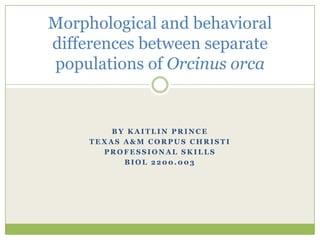
Separate orca populations presentation
- 1. By Kaitlin Prince Texas A&M Corpus Christi Professional Skills BIOL 2200.003 Morphological and behavioral differences between separate populations of Orcinus orca
- 2. Outline Overview of O. orca Importance of classification Definition of species and ecotype Methods Conclusion Discussion
- 3. Current Taxonomy Animalia Chordata Mammalia Cetacea Odontoceti Delphinidae Orcinus orca Classified as a dolphin Common name, “killer whale”, misleading Most widely distributed species after humans Classification can effect conservation status
- 4. Overview of O. orca Dorsal Fin Saddle Patch Eye Patch Adult Male Adult Female Juvenile Figure 1: Diagram of O. orca (1)
- 5. Distribution of O. orca Fig. 2: Distribution of O. orca (2)
- 6. Social Structure of O. orca Pods: small groups of directly related individuals that constantly travel, hunt and live together Clans: related pods that have overlapping ranges and occasionally mingle Communities: sets of clans that regularly intermingle
- 7. Species Ecotype Often defined as a group of organisms capable of interbreeding and producing fertile offspring in the wild Describes a genetically distinct geographic variety, population or race within species which is adapted to specific environmental conditions Definitions of Species and Ecotype
- 8. Methods: Observations Morphological differences Size/shape of eye patch Presence of dorsal cape Size/shape of dorsal fin Behavioral differences Feeding patterns Movement patterns Group size Reviewing available photographs Fig. 3: Type A attacking a minke whale (Pitman, Ensor, 2003)
- 9. Type A Type B O. orca Populations of the Antarctic Typically feed on minke whales No cape markings Medium-sized eye patch Very large eye patch Well-defined cape markings Lighter, grey colored body Typically feed on seals Fig. 5: Type B (Pitman, Ensor, 2003) Fig. 4: Type A (Pitman, Ensor, 2003)
- 10. Type C Physical Comparisons Largest pods Eye patch slanted forward; “smudged” appearance; small, gray body with cape Typically feed on Antarctic cod O. orca Populations of the Antarctic cont. Fig. 7: Comparison of Types (http://en.wikipedia.org/wiki/Killer_whale) Fig. 6: Type C (Pitman, Ensor, 2003)
- 11. Comparison of Type A and Type B Movements Fig. 11: Comparison of Type A and Type B Movements (Pitman, Ensor, 2003)
- 12. Residents Transients O. orca Populations of the North American West Coast Primarily eat fish Live in matrilineal pods More vocalizations Most extensively studied group Exclusively eat marine mammals Typically live in groups of three Less vocalization; complex dialects Fig. 8: Resident dorsal fin (Baird, Abrams, Dill, 1992) Fig. 9: Transient dorsal fin (Baird, Abrams, Dill, 1992)
- 13. Comparison of Residents and Transients Fig. 10: Differences between residents and transients (Baird, Abrams, Dill, 1992)
- 14. Methods: Satellite Tracking Satellite tracking is a useful way to track individuals Small dart with transmitter attached Temporary Fig. 12: Satellite tracking (Russell, Pitman, Ballance, 2008)
- 15. Type B Individual Type C Individual Comparison of Type B and Type C Movements Fig. 13: Satellite tracking (Russell, et. al., 2008) Fig. 14: Satellite tracking (Russell, et. al., 2008)
- 16. Culture Application to O. orca Consists of the beliefs, behaviors, objects, and other characteristics common to the members of a particular group or society Have been shown to teach their young certain behaviors (namely hunting) Pass on specific dialects from one generation to the next Behaviors NOT common to all members of the species, only that pod or clan Definition of Culture and Application to O. orca
- 17. Type D (Antarctic) Offshore (North American West Coast) Identified by mass stranding in New Zealand/handful of sightings Unknown diet Extremely small eye patch; bulbous head Primarily feed on schooling fish Live far from shore; rarely in shallow waters Live in large groups of 20-50, sometimes more Other Possible Groups
- 18. Conclusion Evidence for separate species or subspecies Morphological differences Behavioral differences Geographic isolation Fig. 15: Type B spy-hopping (Pitman, Ensor, 2003)
- 19. Discussion More information is needed on the lesser known groups Genetic analysis of populations would provide evidence of reproductive isolation Important to determine conservation status (endangered) Fig. 16: Type C mother and calf (3)
- 20. References Baird, Robin. Abrams, Peter. Dill, Lawrence. Possible indirect interactions between transient and resident killer whales: implications for the evolution of foraging specializations in the genus Orcinus. 1992. J. Oecologia. 89: 125-132. Pitman, Robert. Ensor, Paul. Three forms of killer whales (Orcinus orca) in Antarctic waters. 2003. J. Cetacean Resource Management. 5(2): 131-139. Russell, Andrews. Pitman, Robert. Ballance, Lisa. Satellite tracking reveals distinct movement patterns for Type B and Type C killer whales in the southern Ross Sea, Antarctica. 2008.J. Polar Biology. 31: 1461-1468.
- 21. Image References (1) http://www.google.com/imgres?imgurl=http://www.acsonline.o rg/factpack/images/KillerWhaleRangeMap.jpg&imgrefurl=http://www.acsonline.org/factpack/orca/kidDistribution.html&usg=__lUmoZMbLL_QUoq3v9uxbWGeenXY=&h=430&w=720&sz=168&hl=en&start=0&zoom=1&tbnid=oOe7Pvao84Mf8M:&tbnh=112&tbnw=188&ei=Ybl3Tc6BDurj0gHC9uSkBw&prev=/images%3Fq%3Dkiller%2Bwhale%2Bdistribution%26um%3D1%26hl%3Den%26client%3Dfirefox-a%26sa%3DX%26rls%3Dorg.mozilla:en-US:official%26channel%3Ds%26biw%3D1366%26bih%3D607%26tbs%3Disch:1&um=1&itbs=1&iact=hc&vpx=117&vpy=111&dur=75&hovh=173&hovw=291&tx=120&ty=114&oei=Ybl3Tc6BDurj0gHC9uSkBw&page=1&ndsp=19&ved=1t:429,r:0,s:0 (2) http://www.acsonline.org/factpack/images/orca-family-med.gif (3) http://en.wikipedia.org/wiki/File:Type_C_Orcas.jpg
Notes de l'éditeur
- Subspecies: differences between subspecies are usually less distinct than the differences between species, but more distinct than the differences between races or breeds
- http://www.youtube.com/watch?v=rBF9cDBUakA– orcas teaching younghttp://www.youtube.com/watch?v=W8GaDuCvYbE – CA2 attacks great white shark
